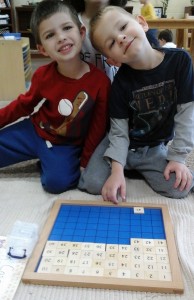The month of April was very busy in our classroom! The children continued to delve into experiencing other cultures and customs, worked very hard on their lines and songs for the International Festival, and we also even learned about the Ocean.
During the first week of April, we learned about the continents of South America and Africa. We first learned that the continent of South America contains the Amazon Rain Forest as well as the Amazon River. The children also learned about the African Savanah and the many animals that reside there, such as lions, impalas, and African Elephants. The children also enjoyed making African necklaces with Ms. Kim during Preschool!
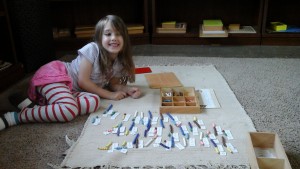
We studied the continents of Europe and Asia during the second week of April. The children enjoyed learning about France and tasting croissants during Preschool Lesson. They also enjoyed learning about Ireland’s green countryside and many castles. We then traveled to Asia where we dove into Japanese music and how songs in Japan were originally composed using only five notes! I even brought in my xylophone to demonstrate for the children the difference between Japanese music, and the style of music we are used to hearing as Americans. We also learned that Japan was formed over time due to the eruption of several volcanoes. We also enjoyed making our own volcano in class!
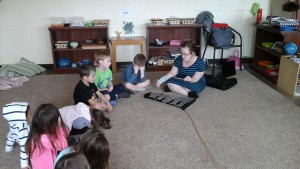
During week three, we traveled to Australia. We learned about Aboriginal Art and discussed the many animals found in Australia, such as kangaroos, wallabies, and wambats. We even had a special speaker come and visit us to tell us all about her trip to ” The Land Down Under”.
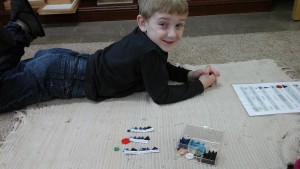
The final week, the children enjoyed learning all about the Oceans. We learned the names of all the oceans, which are Atlantic, Pacific, Indian, and Arctic. I think this was a favorite unit, as the children were excited on the first day to name as many animals as they could that live in the ocean. We learned that not only fish live in the ocean, but mammals such as Orca Whales and Dolphins live in the ocean as well and breathe oxygen from the air, just as we do! The children also enjoyed making a crab craft during preschool lesson with Ms. Kim.
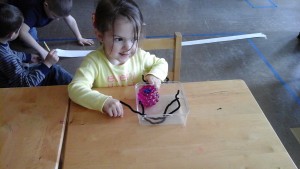
Enrichments (Ms. Kim)
Music
We were happy to see Ms. Lisa back from her trip! She had traveled to El Salvador on a missions trip. She shared with us pictures of the land and the children she worked with. Then Ms. Lisa played us a song that she had used in El Salvador. It was in Spanish, but she told us it means “I Have Joy in My Heart” in English. The children played tambourines to this joyful song. We also reviewed forte (loud) and piano (soft) in different ways. I (Ms. Kim) got to play in on the fun. I pretended to be asleep while the children walked around me singing in their piano voices. Once the music was loud, the children used their forte voices to wake me up! In addition, Ms. Lisa used rhythm sticks to review soft and loud. We tapped them loudly then rubbed them softly to different parts in a song. We then reviewed whole, half, quarter, and eighth notes. Lastly, we learned some new musical vocabulary. Staccato means bumpy and legato means smooth!
Science
Our first science experiment involved a bottle of colored water with vegetable oil and Alka-Seltzer tablets. The children made hypotheses about what would happen when the Alka-Seltzer tablets were dropped into the bottle. When Mr. John dropped a tablet into the bottle, the tablet dissolved but bubbles were created that floated up and down. We found out that when a tablet dissolved, carbon dioxide bubbles were created. The carbon dioxide bubbles carried the colored water to the top of the bottle. At the top of the bottle was the oil, and since oil and water don’t mix, the bubbles fell back down to the bottom.
Our next experiment involved a candle, balloons, and water. Mr. John lit the candle and waved a balloon over it. The balloon popped! Next he blew up another balloon but added water to it. The children made hypotheses about what would happen to this balloon. Did it pop also? No! The water absorbed the heat from the lit candle and prevented the balloon from popping.
Art
In Art we got ready for the International Festival by doing cultural projects. First we made koi fish windsocks to represent Japan. Ms. Michele explained that in Japan koi fish banners are made to represent different members of a family. The children enjoyed creating these windsocks out of construction paper. We used tissue paper, sequins, crayons, and googly eyes to decorate them.
In our next art lesson, the children made Aboriginal paintings to represent Australia. We learned that the Aborigines started pointillism (dot painting) to create pictures. The children drew an animal from Australia, and then filled in the animal by dotting with Q-tips that were dipped into different colored melted clay.
Some things you can do with your child in the coming months to reinforce our themes would be going to the zoo and seeing how many animals your family can find that are from Africa. Try making a French recipe together as a family. Pull up a world map and review the names of the Oceans together. Discuss with your child their favorite sea creature.
Some things you can do with your child in the coming months to reinforce our themes would be going to the zoo and seeing how many animals your family can find that are from Africa. Try making a French recipe together as a family. Pull up a world map and review the names of the Oceans together. Discuss with your child their favorite sea creature.
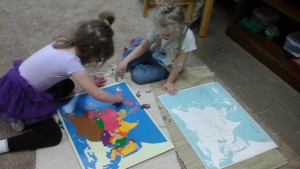
Maria Montessori stated that, “It is true that we cannot make a genius. We can only give to the child the chance to fulfill his potential possibilities.” Remember, every child is unique and develops different skills and abilities at their own pace in their own time. I am very proud of how hard your children work in the classroom, and it is an honor to be their teacher.
